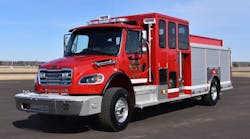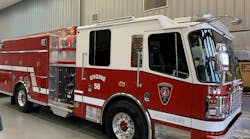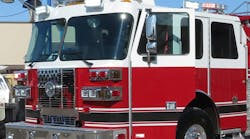TOPIC: BACK TO BASICS: ESTABLISHING SUPPLY LINES
TIME REQUIRED: THREE HOURS
MATERIALS: TWO FULLY EQUIPPED PUMPERS, STATIC AND PRESSURIZED WATER SOURCES
REFERENCES: ESSENTIALS OF FIRE FIGHTING, FOURTH EDITION, IFSTA, CHAPTERS 11 AND 12
PREPARATION:
MOTIVATION: One important activity on the fireground is the ability to move water from the source to where it is needed. All the water in the world will not control or extinguish a fire if it cannot be moved quickly and efficiently. In areas without a pressurized water system, this becomes more critical.
OBJECTIVE (SPO): The firefighter will demonstrate a working knowledge of supplying water to the fireground and, by participation and observation, the various appliances, hose layouts, and procedures involved in supplying water at an emergency scene.
OVERVIEW:
ESTABLISHING SUPPLY LINES
* Supply line evolutions
* Supplying water from various sources
ESTABLISHING SUPPLY LINES
SPO The firefighter will demonstrate a working knowledge of supplying water to the fireground and, by participation and observation, the various appliances, hose layouts, and procedures involved in supplying water at an emergency scene.
EO 1-1 Describe the various hose evolutions used to supply water to the fireground.
EO 1-2 Demonstrate supplying water for fireground operations from various sources.
The purpose of this drill is to review and build on basic skills with the emphasis on improving efficiency and teamwork. It is assumed that the participants have some basic knowledge of the subject matter. The focus of the drill should include personal and team safety. The drill should include minimal instruction and maximum skills practice. The drill should also be conducted with the normal staffing that would respond on an engine on a structure assignment.
I. SUPPLY LINE EVOLUTIONS (1-1)
A. Straight Lay
1. Supply line is laid from the water source to the emergency scene
2. If threaded couplings are used, a female connection is needed if the hose is to be connected to a
hydrant
3. Hydrant valve may be connected to end of supply hose and connected to the hydrant
B. Reverse Lay
1. Supply line is laid from the scene to the water source
2. If threaded couplings are used, a male connection is needed to connect to a siamese for a
standpipe or sprinkler system or another engine at the scene
3. If the engine is laying hose to a hydrant, a soft sleeve, hard sleeve, or section of supply line can
be used to connect to the hydrant
4. If water is being taken from a static source, it will require setting up for draft
C. Split Hose Lays
1. Combination of a forward lay and a reverse lay
2. Utilizes two pumpers to complete
3. May require a double female or a double male to connect, dependent on how the supply line is
loaded on the engine and the couplings at the end of each hose
D. Review Various Hose Lays and Means of Obtaining Water
1. Laying a single supply line from the hydrant to the scene
a. Remove the amount of hose necessary to reach hydrant along with any adapters and a
hydrant wrench
b. Once the hose is secured against the hydrant, signal the apparatus driver that it is safe to move
the engine
c. Connect to the hydrant using the 4-1/2-inch steamer connection (LDH) or one of the
2-1/2-inch connections (2-1/2-inch or 3-inch)
d. If a hydrant valve is to be used, connect the hydrant valve to the steamer connection
e. Open the hydrant completely and back off one-half turn
f. If a supply engine is to be used, connect the supply line to the supply engine
g. At the scene, the driver or other designated person will disconnect the supply line and connect
it to the intake on the pump panel
2. Laying dual lines of 2-1/2-inch or 3-inch supply line from the hydrant to the scene
a. Remove the amount of hose necessary to reach the hydrant along with any adapters and a
hydrant wrench
b. Once the hose is secured against the hydrant, signal the apparatus driver that it is safe to move
the engine
c. Connect to the hydrant using the two 2-1/2-inch hydrant connections
d. If a hydrant valve is to be used for one of the lines, connect the hydrant valve to the steamer
connection and the other line to one of the 2-1/2-inch connections
e. Open the hydrant completely and back off one-half turn
f. If a supply engine is to be used, connect the supply lines to the supply engine
g. At the scene, the driver or other designated person will disconnect the supply lines and
connect them to the intake on the pump panel
3. Laying a single LDH line from the scene to the water source
a. Remove the coupling along with sufficient hose to reach the attack pumper or siamese as well
as any adapters needed
b. Once the hose is secured to a fixed object, signal the apparatus driver that it is safe to move
the engine
c. Connect the hose to the intake on the attack engine or the siamese on the sprinkler or
standpipe system
d. At the water source, the engine will be set up to receive water from a hydrant or a static draft
source
4. Laying dual lines of 2-1/2-inch or 3-inch supply line from the scene to the water source
a. Remove the coupling along with sufficient hose to reach the attack pumper or siamese as well
as any adapters needed
b. Once the hose is secured to a fixed object, signal the apparatus driver that it is safe to move
the engine
c. Connect the hose to the intake on the attack engine or the siamese on the sprinkler or
standpipe system
d. At the water source, the engine will be set up to receive water from a hydrant or a static draft
source
5. Hydrant connection
NOTE: Hard sleeves can be used for hydrant operations but they are designed for drafting
operations and may not withstand the hydrant pressure
a. Engine can connect to the streamer connection using a soft sleeve
b. Engine can connect to the 2-1/2-inch connections using a section of supply line (2-1/2-inch
to 5-inch)
c. If a hydrant valve is used, the engine can connect to the hydrant valve using a soft sleeve (a
separate supply line will be needed to connect the engine to the hydrant valve to boost the
pressure in the supply line)
d. If the steamer connection is used, a hydrant gate or ball valve can be connected to one of the
2-1/2-inch hydrant connections for later use as needed
e. If the hydrant has plenty of water and pressure, the engine at the hydrant can connect to both
the steamer and the 2-1/2-inch connections or two engines connect to the hydrant
f. The hydrant should be opened and closed completely while backing off one-half turn when
opening or closing
6. Setting up for draft
a. Drafting can be done from any static water source including a portable tank
b. Drafting involves the use of one or more sections of hard sleeve and some type of strainer
device on the end of the hard sleeve
c. The hard sleeve(s) should be connected and all connections are made air tight using a rubber
mallet
d. A strainer should be placed on the end of the hard sleeve that is to be placed in the water
source (a low level strainer may be used with a portable tank) to prevent debris from
damaging the pump
e. The female connection on the hard sleeve should be connected to one of the steamer
connections on the pumper (preferably one on either side of the pump rather than a front or
rear intake)
f. A rope should be attached to the strainer for later retrieval as well as to assist in keeping the
strainer off the bottom of a pond, lake, or stream bed
g. If large quantities of water are needed and pumper capacity is insufficient, more than one
pumper may be used at the water source with the water being pumped into a Siamese or
gated Siamese
7. Water relay
a. Involves the use of multiple pumpers to move water longer distances
b. Begins at the water source with the supply pumper setting up at a hydrant or static source
c. As each pumper to participate in the relay arrives, they begin laying hose from the supply
pumper to the scene
d. Each pumper participating in the relay should not generally lay more than 1,000 feet of hose
to keep engine pressure down (lesser friction loss to overcome)
e. The last pumper in the relay will supply water to the attack pumper
f. Flow of water starts with the supply pumper
g. Manifolds, water thiefs, or gated wyes may be used at the scene to provide water to more
than one attack pumper
8. Rural operation with nurse tanker or portable tank
a. Lay LDH, either 4-inch or 5-inch, from end of lane back to fire scene
b. Manifold or wye used to distribute water at scene
c. LDH supplied from portable tanks or nurse tanker
d. Reduces need for extra apparatus at scene when not needed
e. Provides mobility for moving water during shuttling operations
II. SUPPLYING WATER FROM VARIOUS SOURCES (1-2)
A. The student will perform the following evolutions using as many of the appliances described above
as possible. There are other evolutions that could be considered depending on local need and
capability.
1. Lay a supply line from a hydrant using LDH and hydrant valve, connect the hydrant valve to the
hydrant, charge the supply line, connect another engine to the hydrant, and have the supply
engine supply the attack engine through the hydrant valve.
2. Reverse lay from engine or Siamese to source and set up water supply from a pressurized
source.
3. Using the reverse lay, set up water supply from a static source using LDH, to supply a second
engine at the scene.
4. Using the split lay, set up water supply from a pressurized source using a single line to supply a
second engine at the scene.
5. Set up water supply from a portable tank using multiple engines. The evolution should include
one engine operating as the attack unit and another engine operating as the supply unit at the
portable tank. One of the units will be required to set up the portable tank which can be filled
from a hydrant or tanker.
6. Using a straight lay, set up water supply without a hydrant valve from a pressurized source
using LDH while initiating supply from a booster tank.
7. Using a reverse lay, set up water supply from a static source to a master stream device using a
single supply line while initiating supply from a booster tank.
8. Set up a relay involving at least three pumpers and using a static water source. The relay
should flow at least 500 GPM.
9. Have one engine connect to the steamer connection on the hydrant while second engine
connects to the 2-1/2-inch connections (a hydrant gate or ball valve may be used to avoid
shutting down the hydrant to allow the second pumper to connect)
B. All water will be discharged into a master stream device which is already set up or connected
directly to the pump.
C. These evolutions are designed to expose the student to various methods of supplying water at the
fire scene. The student should already be familiar with the techniques involved in each evolution.
What is being emphasized here is teamwork and operating efficiency.
REVIEW:
ESTABLISHING SUPPLY LINES
* Supply line evolutions
* Supplying water from various sources
REMOTIVATION: Some of these evolutions can be performed by a single department while others may require assistance from neighboring departments. The drill provides an opportunity for interdepartmental drill that will benefit everyone. If the movement of water is not practiced on a regular basis, it will not be quick and efficient when needed. It is also an opportunity to develop or update procedures and practice some segments of the incident command system.






